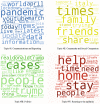Framing COVID-19: How we conceptualize and discuss the pandemic on Twitter
- PMID: 32997720
- PMCID: PMC7526906
- DOI: 10.1371/journal.pone.0240010
Framing COVID-19: How we conceptualize and discuss the pandemic on Twitter
Erratum in
-
Correction: Framing COVID-19: How we conceptualize and discuss the pandemic on Twitter.PLoS One. 2024 Jul 2;19(7):e0306644. doi: 10.1371/journal.pone.0306644. eCollection 2024. PLoS One. 2024. PMID: 38954683 Free PMC article.
Abstract
Doctors and nurses in these weeks and months are busy in the trenches, fighting against a new invisible enemy: Covid-19. Cities are locked down and civilians are besieged in their own homes, to prevent the spreading of the virus. War-related terminology is commonly used to frame the discourse around epidemics and diseases. The discourse around the current epidemic makes use of war-related metaphors too, not only in public discourse and in the media, but also in the tweets written by non-experts of mass communication. We hereby present an analysis of the discourse around #Covid-19, based on a large corpus tweets posted on Twitter during March and April 2020. Using topic modelling we first analyze the topics around which the discourse can be classified. Then, we show that the WAR framing is used to talk about specific topics, such as the virus treatment, but not others, such as the effects of social distancing on the population. We then measure and compare the popularity of the WAR frame to three alternative figurative frames (MONSTER, STORM and TSUNAMI) and a literal frame used as control (FAMILY). The results show that while the FAMILY frame covers a wider portion of the corpus, among the figurative frames WAR, a highly conventional one, is the frame used most frequently. Yet, this frame does not seem to be apt to elaborate the discourse around some aspects involved in the current situation. Therefore, we conclude, in line with previous suggestions, a plethora of framing options-or a metaphor menu-may facilitate the communication of various aspects involved in the Covid-19-related discourse on the social media, and thus support civilians in the expression of their feelings, opinions and beliefs during the current pandemic.
Conflict of interest statement
The authors have declared that no competing interests exist.
Figures







References
-
- Flusberg SJ, Matlock T, Thibodeau PH. War metaphors in public discourse. Metaphor and Symbol 2018. 331 1–18. 10.1080/10926488.2018.1407992 - DOI
-
- Culotta A. Towards Detecting Influenza Epidemics by Analyzing Twitter Messages. Proceedings of the First Workshop on Social Media Analytics. SOMA’10. New York, NY, USA: ACM; 2010. p. 115–122.
-
- Gomide J, Veloso A, Meira W Jr, Almeida V, Benevenuto F, Ferraz F, et al. Dengue Surveillance Based on a Computational Model of Spatio-temporal Locality of Twitter. Proceedings of the 3rd International Web Science Conference. WebSci’11. New York, NY, USA: ACM; 2011. p. 3:1–3:8.
MeSH terms
LinkOut - more resources
Full Text Sources
Miscellaneous

